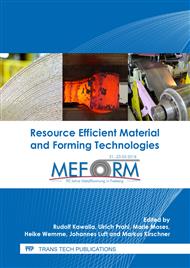[1]
E. Aryshenskii, R. Kawalla, J. Hirsch, Development of New Fast Algorithms for Calculation of Texture Evolution during Hot Continuous Rolling of Al–Fe Alloys, steel research int. (2017) 1700053-n/a.
DOI: 10.1002/srin.201700053
Google Scholar
[2]
J. Hirsch, Through Process Modelling, Materials Science Forum 519-521 (2006) 15–24.
Google Scholar
[3]
S.V. Rushchits, E.V. Aryshenskii, R. Kawalla, V. Serebryany, Investigation of Texture Structure and Mechanical Properties Evolution during Hot Deformation of 1565 Aluminum Alloy, Materials Science Forum 854 (2016) 73–78.
DOI: 10.4028/www.scientific.net/msf.854.73
Google Scholar
[4]
J. Hjelen, R. Ørsund, E. Nes, On the origin of recrystallization textures in aluminium, Acta Metallurgica et Materialia 39 (1991) 1377–1404.
DOI: 10.1016/0956-7151(91)90225-p
Google Scholar
[5]
M.A. Wells, I.V. Samarasekera, J.K. Brimacombe, E.B. Hawbolt, D.J. Lloyd, Modeling the microstructural changes during hot tandem rolling of AA5XXX aluminum alloys: Part III. Overall model development and validation, Metallurgical and Materials Transactions B 29 (1998).
DOI: 10.1007/s11663-998-0106-y
Google Scholar
[6]
J. Hirsch, Texture Evolution and Earing in Aluminium Can Sheet, Materials Science Forum 495-497 (2005) 1565–1572.
DOI: 10.4028/www.scientific.net/msf.495-497.1565
Google Scholar
[7]
S. -J. Park, B. -H. Hong, S.C. Baik, K.H. Oh, Finite Element Analysis of Hot Rolled Coil Cooling, ISIJ International 38 (1998) 1262–1269.
DOI: 10.2355/isijinternational.38.1262
Google Scholar
[8]
A. Nam, U. Prüfert, M. Eiermann, R. Kawalla, Numerical Modeling of Thermal Evolution in Hot Strip Rolling of Magnesium Alloy, Key Engineering Materials 651-653 (2015) 207–212.
DOI: 10.4028/www.scientific.net/kem.651-653.207
Google Scholar
[9]
K. Karhausen, W. Schneider, Effect of Material Property Changes on the Performance of Al Rolling Mills, Materials Science Forum 638-642 (2010) 247–254.
DOI: 10.4028/www.scientific.net/msf.638-642.247
Google Scholar
[10]
Michael J. Ryan, Stephen G. R. Brown, Peter J. Eva, The Effect of Hot Mill Processing Temperature Variations on Final Coil Properties of Hot Rolled Steels, PR-362-179 - 2012 AISTech Conference Proceedings (2012) 1591–1600.
Google Scholar
[11]
S.S. Sahay, B.V. Harish Kumar, S.J. Krishnan, Microstructure evolution during batch annealing, Journal of Materials Engineering and Performance 12 (2003) 701–707.
DOI: 10.1361/105994903322692510
Google Scholar
[12]
Z.D. Liu, D.Q. Jin, Samarasekera IV, J.K. Brimacombe, The application of microstructure engineering in steel coil cooling process, J. of Iron and Steel Research Intl 12 (2005).
Google Scholar
[13]
J. Hirsch, K. Karhausen, R. Kopp, Microstructure Simulation During Hot Rolling Of Al-Mg Alloys, ICAA4, Proceedings of the 4th International Conference on Al alloys, Atlanta/GA USA (1994).
Google Scholar
[14]
D.W. Hahn, M.N. Özișik, Heat conduction, third. ed., [elektronische Ressource], Wiley, Hoboken, NJ, (2012).
Google Scholar
[15]
M.N. Özişik, Heat conduction, third. ed., Wiley, New York, (2012).
Google Scholar
[16]
M. Pietrzyk, L. Madej, L. Rauch, D. Szeliga, Computational Materials Engineering: Achieving High Accuracy and Efficiency in Metals Processing Simulations, Elsevier Science & Technology Books, (2015).
DOI: 10.1016/b978-0-12-416707-0.00006-5
Google Scholar
[17]
E.V. Aryshenskii, V.Y. Aryshenskii, A.F. Grechnikova, E.D. Beglov, Evolution of Texture and Microstructure in the Production of Sheets and Ribbons from Aluminum Alloy 5182 in Modern Rolling Facilities, Metal Science and Heat Treatment 56 (2014).
DOI: 10.1007/s11041-014-9760-7
Google Scholar
[18]
V.Y. Aryshenskii, Development of a mechanism of the desirable anisotropy and mechanical properties formation during hot rolling of aluminum strip for deep drawing. habilitation thesis, Samara, (2002).
Google Scholar
[19]
S.P. Chen, Recovery and Recrystallization Kinetics in AA1050 and AA3003 Aluminium Alloys (2003).
Google Scholar
[20]
M.S. Kaiser, Fractional Recrystallization Behaviour of Al-Mg Alloy with Different Sc Addition Content (2014).
DOI: 10.12720/ijmse.2.2.136-140
Google Scholar


